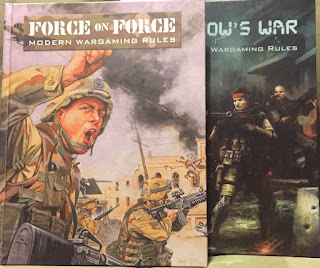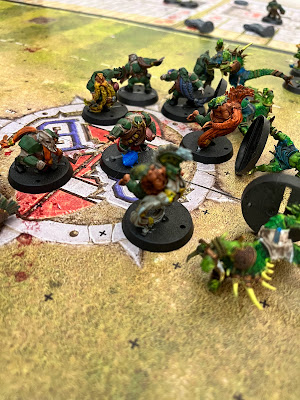I seem to recall something called the Grand Unified Theory in particle physics. I am not a particle physicist, or much of a science lay-person for that matter. I seem to recall it was a theory to bring Quantum physics and General Relativity together into one framework for understanding the universe. Binding weak forces like electricity and magnetism together with the strange and unknown powers that bind the smallest atomic structures together. This is referred to in physics as the Theory of Everything.
So, what does this have to do with Wargaming? A strong set of wargaming rules should also run under a Theory of Everything or Grand Unifying Theory model. Simply put, if rolling over a Target Number on a d6 is how you resolve the main mechanic of your game, then all game mechanics should use this same model.
This is a surprisingly controversial contention! There is a large number of successful games that do not use a Grand Unified Theory of Everything in their game design. Instead, their mechanics may run on a number of mini-games or alternate methods for resolving gameplay interactions. Again, put simply a game without a Grand Unified Theory of Everything may have you roll to beat a Target Number on a d6 for shooting, but then have you add up Mods with the highest winning when it is time to hit something with a stick. Two different mechanics used to solved different game interactions.
Lets look at a few examples to help illustrate the point:
1. In Warhammer 40K 2nd Edition, you used a chart when shooting to determine the target number to hit a foe. The opponents Ballistic skill played no part in the process. However, when fighting in hand-to-hand, you compared the attacker and targets Weapon Skill to determine the target number. The greater the mis-match between the two stats the easier/harder it was to connect.
This is a Non-Grand Unified Theory of Everything approach.
2. In Outremer: Faith and Blood from Osprey, the Target Number to succeed on a roll was 4+. However, modifiers applied to the size of dice you rolled, but a 4+ was always a success. This applied to shooting, hand-to-hand, psychology, etc. Modifiers always changed the size of dice you were using.
This is an example of Grand Unified Theory of Everything mechanics.
Why a Grand Unified Theory of Everything Mechanic
Developing this type of mechanical approach to a game, is the hardest level of game design. However, the benefits are great.
1. Improves ease of learning
Once a player grasps the core concepts of the game, they never change. This greatly reduces the ease of play and the learning curve for new games.
2. Less cognitive load on the players
The player does not have to remember a bunch of If This/Then That mechanics, as they same core resolution methods exist.
3. Streamlined play
The game itself can be expressed and executed in a quick, concise and streamlined manner. The rules can then be summarized and expressed quickly and cleanly in a few pages. The rules interactions are less complex.
4. Fewer misunderstandings
The players know the Grand Unified Theory of Everything, and will easily be able to apply it to edge cases and avoid arguments.
Why Wouldn't You Want a Grand Unifying Mechanic of Everything?
Of course, there have many successful system that do not use the Grand Unified Mechanic of Everything. There are a few reasons why designers may opt NOT to try and generate one for their games.
1. They are HARD
It is not easy to come up with a Grand Unifying Mechanic of Everything! Wargames are trying to cover a wide range of time frames, genres, and interactions and sometimes you just can't get them all to fit.
2. It Doesn't DO What the Designer Wants
The rule of thumb for designing wargames is that the mechanics want to reflect the outcomes the designer wants to happen. Sometimes, a Grand Unified Mechanic of Everything can not make it all come together the way the designer intends.
3. Samey- Samey
Sometimes, a Grand Unified Mechanic of Everything does not allow the designer to express the uniqueness of the different elements of the game the designer wishes. For example, your super-soldiers seem less super, or your aliens seem less alien.
I strongly encourage any aspiring game designers to strive to create a Grand Unifying Mechanic of Everything for all of their games. For me, the benefits outweigh the costs. As you gain experience and expose yourselves to a variety of games, I have found that this process gets easier. However, it is not a "deal breaker" for a game to not feature a Grand Unifying Mechanic of Everything. Many successful games and systems do not have this as a feature.
As always, the best choice of mechanics is the one that creates what the design is intending to create with their game.
Good luck!
Bonus Content
In honor of the Super Bowl, we pulled out the Blood Bowl boxed set. We randomly rolled for the teams that I had and came up with Dwarfs vs. Lizard Men. I took control of the Dwarf team and we got playing.
The Lustria's Revenge took an early lead when a Skink managed to scoot around the edge of the line and managed to get to the end zone. However, it cost the Revenge as a Lizard Man was taken out of the game.
Then, the Dwarf Rock-n-Rollaz got the ball and went to work. There wasn't enough time for them to score, but they did manage to take out a skink and another Lizard!
The Revenge kicked it back to the Dwarf team, and a nice reliable Dwarf cage managed to smash their way to the end zone. However, they left about half of the half for the Revenge to retaliate.
The kick-off went out to Revenge, and thanks to a touch back they gave it to a skink. Some amazing hits early on knocked-out three dwarves in a handful of turns. That really helped open up the field. The Revenge managed to rush back in and score putting them up 2-1.
The Rock-N-Rollaz got the ball back, and their three Dwarfs back to the field. However, there just is not enough time for them to get back down the field. Game over, and the Revenge wins 2-1.
I hope you enjoyed these extra Blood Bowl content. Later all.
Become a Patron and get access to all the cool stuff, a peak behind the curtain of Blood and Spectacles, and early-access to playtest games!
You can follow Blood and Spectacles Facebook page or Instagram for more fun!
Check out the latest publications and contact me at our Blood and Spectacles website











I would go with the Grand Unifying Mechanic (GUM). The secret, from a design point of view, is to get the GUM to do all the things you want. The most basic GUM is high is good, low is bad, but how many rules have this consistently?
ReplyDeleteHerbal Supplement for Premature Ejaculation have become an increasingly popular option for those looking for natural treatments for premature ejaculation. Some herbs have been found to help improve symptoms of premature ejaculation by increasing blood flow to the pelvic region and helping to relax muscles in the area. Other herbs may help increase levels of serotonin in the brain, which has been associated with longer lasting sexual experiences. Additionally, some herbal supplements are said to help reduce stress and anxiety levels which can contribute to premature ejaculation.
ReplyDelete